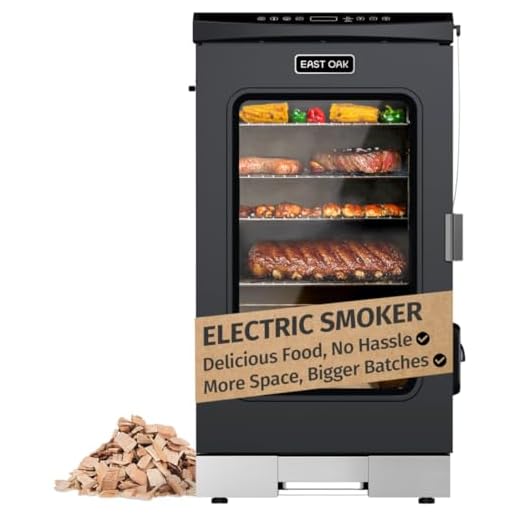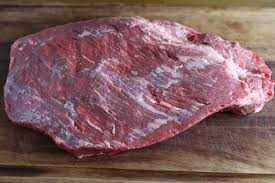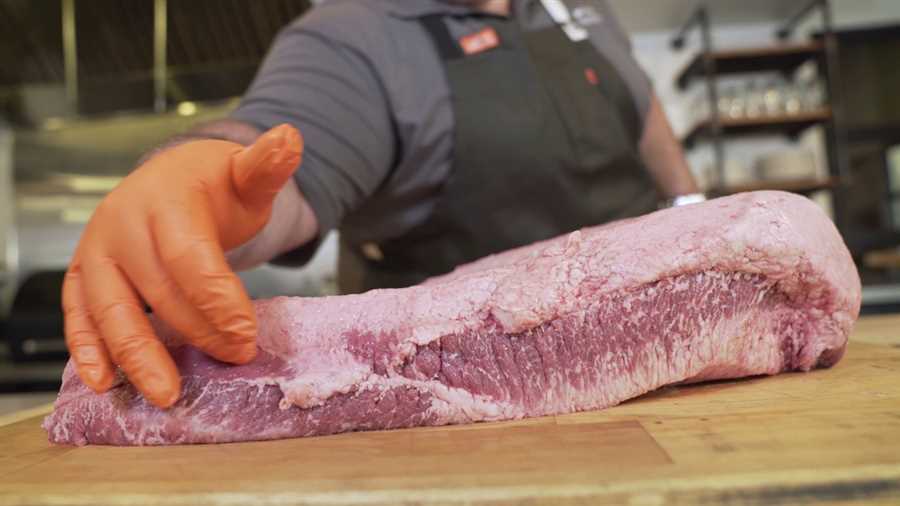





Brisket is a popular cut of beef that is often cooked low and slow to achieve tender and flavorful results. One question that often arises when cooking brisket is whether to cook it fat side up or down. This article will explore the arguments for both methods and provide some tips for achieving the best results.
Cooking brisket with the fat side up is a common method that many barbecue enthusiasts swear by. The theory is that as the brisket cooks, the fat will render down and baste the meat, keeping it moist and adding flavor. Additionally, with the fat side up, the meat is protected from direct heat, which can help prevent it from drying out.
On the other hand, some people prefer to cook brisket with the fat side down. They argue that this allows the fat to act as an insulating layer, helping to protect the meat from drying out. Additionally, cooking the brisket with the fat side down can help promote a nice caramelization on the meat, adding an extra layer of flavor.
Must-HaveMasterbuilt 30-Inch Digital Electric SmokerFeatures patented side wood chip loaderThis vertical electric smoker offers 710 square inches of cooking space and a side woodchip loader for continual smoking without losing heat. Perfect for smoking multiple meats at once, it ensures flavorful low-and-slow cooking with ease.Ultimately, whether you cook brisket fat side up or down is a matter of personal preference. It’s important to consider factors such as the type of smoker or grill you’re using, the size and shape of the brisket, and your desired outcome. Experimenting with different methods can help you find the technique that works best for you.
Remember, the key to a successful brisket is cooking it low and slow, regardless of whether you choose to cook it fat side up or down. Patience and attention to detail will yield delicious results every time.
What is brisket and how to cook it
Brisket is a popular cut of beef that comes from the chest area of the cow. It is known for its rich flavor and tender texture. Brisket can be used in a variety of dishes, but it is most commonly associated with barbecue.
Selecting and preparing brisket
When selecting a brisket, it’s important to choose one that has a good amount of marbling, as this will help to keep the meat moist and flavorful during cooking. You can also choose between a flat cut brisket, which is leaner and more uniform in shape, or a point cut brisket, which has more fat and is generally considered to be more flavorful.
Before cooking brisket, it’s a good idea to trim away any excess fat, as this can help to prevent the meat from becoming greasy. However, it’s important to leave some fat on the brisket to add flavor and prevent it from drying out during cooking.
Cooking brisket
There are several methods for cooking brisket, but one of the most popular is slow smoking. This involves cooking the brisket at a low temperature over a long period of time, which allows the fat to render and the connective tissues to break down, resulting in a tender and flavorful meat.
To cook brisket, you can season it with a dry rub or marinade of your choice, then place it fat side up or fat side down on the grill or smoker. There is some debate among cooks as to which way is best, but the general consensus is that fat side up allows the fat to baste the meat as it cooks, resulting in a more moist and flavorful end result.
During cooking, it’s important to monitor the temperature of the brisket to ensure that it doesn’t overcook or dry out. The ideal temperature for brisket is around 225°F to 250°F (107°C to 121°C). It can take anywhere from 8 to 12 hours to cook a brisket, depending on its size and the cooking method used.
Serving brisket
Once the brisket is cooked to perfection, it’s important to let it rest for 15 to 30 minutes before slicing. This allows the juices to redistribute and the meat to become more tender. Brisket can be served on its own, sliced thin and piled high on a sandwich, or used as an ingredient in other dishes like tacos or chili.
Overall, cooking brisket requires patience and attention to detail, but the end result is well worth the effort. Whether you choose to smoke it, roast it, or braise it, brisket is a delicious and satisfying cut of meat that is sure to impress.
Why fat side up is preferred by some
There is some debate among barbecuers on whether to cook brisket fat side up or down. While both methods can result in delicious brisket, many pitmasters prefer to cook it with the fat side up. Here are a few reasons why fat side up is preferred by some:
1. Protection and Moisture

Placing the fat side up acts as a natural barrier, protecting the meat from direct heat. This helps prevent the meat from drying out during the long cooking process. The layer of fat also helps baste the meat as it renders, keeping it moist and flavorful.
2. Enhanced Flavor
Cooking brisket fat side up allows the melting fat to infuse the meat with its rich flavor. As the fat slowly renders, it penetrates the meat, adding a delicious savory taste. This helps create a more succulent and flavorful brisket.
It is important to note that some pitmasters prefer to cook brisket fat side down, arguing that it allows the fat to baste the meat from below. There is no right or wrong way to cook brisket – it ultimately comes down to personal preference and the desired outcome. Experimenting with both methods can help you find your preferred cooking style.
| Pros of cooking fat side up: | Cons of cooking fat side up: |
|---|---|
| Protection from direct heat | Potential for a greasier finished product |
| Moisture retention and basting | Less sear and browning on the meat |
| Enhanced flavor infusion | Less direct interaction of fat with the meat |
Why fat side down is preferred by others
While some people argue for cooking brisket fat side up, others prefer to cook it fat side down. Here are a few reasons why fat side down is preferred by some:
1. Protection: Cooking brisket with the fat side down provides a layer of protection between the meat and the heat source. This helps to prevent the meat from drying out and becoming tough. The layer of fat acts as an insulation, keeping the meat juicy and flavorful.
2. Reduced Risk of Flare-Ups: Placing the fat side down helps to minimize flare-ups that can occur when the fat drips onto the flames or heating element. This is especially important when using a grill or smoker, where direct flame contact can cause the brisket to become charred or burnt.
3. Enhanced Flavor: Cooking brisket with the fat side down allows the rendered fat to baste the meat as it cooks. This helps to enhance the flavor, as the fat and juices from the meat are distributed evenly throughout the brisket. This results in a more tender and flavorful end product.
4. Presentation: Cooking the brisket fat side down can also improve the appearance of the final dish. By cooking with the fat side down, you can achieve a more uniform and attractive crust on the top of the brisket.
It’s important to note that the preferred method of cooking brisket may vary depending on personal preference and the cooking equipment being used. Ultimately, the choice of cooking fat side up or down is up to you and how you prefer to prepare your brisket.
Key factors to consider when deciding how to cook brisket

When it comes to cooking brisket, one of the main debates is whether to cook it fat side up or fat side down. While there is no definitive answer, there are a few key factors to consider when making this decision.
Cooking method: The cooking method you choose can influence whether you should cook the brisket fat side up or down. For example, if you’re cooking the brisket on a grill or smoker, many experts recommend cooking it fat side up. This allows the fat to render and baste the meat as it cooks, resulting in a moist and flavorful brisket. On the other hand, if you’re cooking the brisket in an oven or slow cooker, cooking it fat side down can help to protect the meat from drying out.
Size and shape of the brisket: The size and shape of the brisket can also play a role in determining how to cook it. A larger, thicker brisket may benefit from being cooked fat side up, as the fat can help to insulate the meat and keep it moist during the cooking process. However, a smaller, thinner brisket may not benefit as much from cooking fat side up, as it may already have enough moisture and fat content to remain tender and juicy.
Personal preference: Ultimately, the decision of whether to cook brisket fat side up or down may come down to personal preference. Some people prefer the rich, smoky flavor that cooking fat side up can impart, while others prefer the slightly leaner texture that cooking fat side down can result in. It may be worth experimenting with both methods to see which one you prefer.
Temperature control: Regardless of whether you cook brisket fat side up or down, maintaining a consistent cooking temperature is key. This will ensure that the brisket cooks evenly and becomes tender and juicy. Use a meat thermometer to monitor the internal temperature of the brisket and make any necessary adjustments to the cooking temperature.
In conclusion, when deciding how to cook brisket, consider the cooking method, the size and shape of the brisket, personal preference, and temperature control. These factors will help guide you in making the best decision for cooking a tender and delicious brisket.
Expert opinions and recommendations
When it comes to cooking brisket, there is a lot of debate regarding whether it should be cooked fat side up or fat side down. While personal preferences may vary, there are some expert opinions and recommendations that can help guide your decision.
- Fat side up: Some experts recommend cooking brisket with the fat side up. This allows the fat to slowly render down into the meat, basting it and keeping it moist throughout the cooking process. It also provides a protective layer that can help prevent the meat from drying out.
- Fat side down: On the other hand, there are experts who prefer cooking brisket with the fat side down. They argue that this allows the fat to act as an insulator, protecting the meat from the intense heat of the cooking surface and helping to keep it tender and juicy.
Ultimately, the decision of whether to cook brisket fat side up or fat side down is up to you. Consider experimenting with both methods to see which one produces the best results for your taste and cooking style. Remember, the most important thing is to cook the brisket low and slow, allowing enough time for the collagen to break down and the meat to become tender and flavorful.
Questions and answers
Which side should I cook the brisket on, fat side up or down?
When cooking brisket, it is generally recommended to cook it with the fat side up. This allows the fat to render down and baste the meat as it cooks, resulting in a more tender and flavorful brisket. However, some people prefer to cook the brisket fat side down, believing that it helps to protect the meat from drying out. Ultimately, it comes down to personal preference and the specific recipe you are using.
Does cooking the brisket fat side up make it more tender?
Cooking the brisket fat side up can help make it more tender. The layer of fat on top of the brisket helps to baste the meat as it cooks, keeping it moist and flavorful. As the fat renders down, it infuses the meat with its rich flavors, resulting in a tender and juicy brisket.
What are the advantages of cooking brisket fat side down?
Some people prefer to cook brisket fat side down because they believe it helps to protect the meat from drying out. By placing the fat side down, the layer of fat acts as a barrier between the heat source and the meat, helping to insulate and retain moisture. Additionally, cooking brisket fat side down can also result in a deliciously crispy bark on the top of the brisket.
Should I trim the fat off the brisket before cooking?
Trimming the fat off the brisket is a personal preference. Some people prefer to leave a layer of fat on the brisket to help keep it moist and flavorful during cooking. However, others choose to trim off excess fat for a leaner end result. If you decide to trim the fat, it is important to leave a thin layer intact to prevent the meat from drying out.
Does cooking the brisket fat side down affect the bark?
Cooking the brisket fat side down can affect the bark, or the crispy outer layer of the meat. When the fat side is down, it can prevent the meat from developing a crispy bark as the fat acts as a barrier between the heat and the meat. However, some people prefer this method as it can result in a more tender and moist brisket.
Should I cook brisket fat side up or down?
There is some debate among pitmasters about whether to cook brisket fat side up or down. However, the general consensus is to cook it fat side up. This allows the fat to melt and render down into the meat, keeping it moist and adding flavor. It also acts as a natural basting agent, helping to keep the meat tender and juicy.






